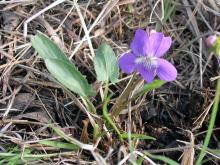Wildflowers, Grasses and Other Nonwoody Plants
Media

Species Types
Scientific Name
Viola spp.
Description
Violets, as a group, are fairly easy to identify, with their colorful five-petaled “faces” so welcome in springtime. Missouri has 17 species, and some are confusingly similar. This page introduces them as a group.
Media

Species Types
Scientific Name
Viola palmata (syn. V. triloba)
Description
The leaf blades of cleft violet are highly variable, and the plant produces differently shaped leaves as the season progresses. Midseason leaves have a broad central lobe flanked by additional lobes toward the base.
Media

Species Types
Scientific Name
Utricularia spp.
Description
Bladderworts are Missouri’s only carnivorous plants. They are branching, rootless, aquatic plants that tend to grow in thick, floating mats under the water. The leaves are threadlike. The flowers resemble tiny yellow snapdragons and are held above the water.
Media

Species Types
Scientific Name
Heteranthera spp.
Description
Mud plantains have glossy, rounded or kidney-shaped leaves and purple or white flowers that have six petal lobes. One petal lobe points downward. They typically grow as emergent aquatic shoreline plants.
Media

Species Types
Scientific Name
Viola viarum
Description
The leaf blades of plains, or wayside violet are highly variable, and the plant produces differently shaped leaves as the season progresses. It’s quite similar to cleft violet, but the leaves are smooth and hairless.
Media

Species Types
Scientific Name
Viola sagittata
Description
Arrow-leaved violet, or arrowhead violet, is a native Missouri perennial spring wildflower that grows in prairies, glades, and woodland openings. It has distinctive arrowhead-shaped leaves.
See Also
About Wildflowers, Grasses and Other Nonwoody Plants in Missouri
A very simple way of thinking about the green world is to divide the vascular plants into two groups: woody and nonwoody (or herbaceous). But this is an artificial division; many plant families include some species that are woody and some that are not. The diversity of nonwoody vascular plants is staggering! Think of all the ferns, grasses, sedges, lilies, peas, sunflowers, nightshades, milkweeds, mustards, mints, and mallows — weeds and wildflowers — and many more!





















